Fantasia 2016, Day 16: Two Fish Stories (Collective Invention and Too Young To Die!
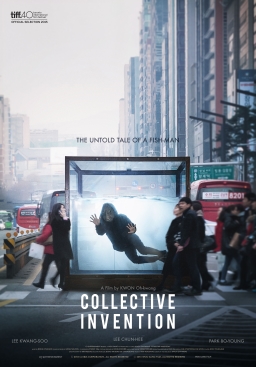 By July 29, the sixteenth day of the Fantasia Festival, I was beginning to feel exhausted. I’d had some thoughts of watching three movies that Friday, but in the end could only manage two. I made it down to the Hall Theatre in the afternoon to watch the Korean satire Collective Invention (Dolyeonbyuni), then came back right after for the raucous Japanese comedy Too Young To Die! (Too Young To Die! Wakakushite Shinu). Neither struck me as flawless, but both in different ways were interesting experiences.
By July 29, the sixteenth day of the Fantasia Festival, I was beginning to feel exhausted. I’d had some thoughts of watching three movies that Friday, but in the end could only manage two. I made it down to the Hall Theatre in the afternoon to watch the Korean satire Collective Invention (Dolyeonbyuni), then came back right after for the raucous Japanese comedy Too Young To Die! (Too Young To Die! Wakakushite Shinu). Neither struck me as flawless, but both in different ways were interesting experiences.
Collective Invention tells the story of Park Gu (Lee Kwang-soo), a Korean man whose head has been changed into that of a giant fish thanks to unexpected side effects from medical tests. We get his story through the eyes of Sang-won (Lee Cheon-hee), an aspiring reporter who breaks Park’s story and makes him famous. Park’s not entirely happy about becoming a major media figure, and the medical company behind his transformation isn’t happy about the bad publicity they get. Their counterpunches, and the ups and downs of Park’s life and public profile, make the spine of the movie — along with the moral choices Sang-won and the others around him find themselves making, balancing the exploitation of Park against their own careers and ideals.
Directed and written by Kwon Oh-kwang, Collective Invention is a wide-ranging satire. It reads to me as though it takes on specific targets (the media, fame, the medical industry, the law, and more) as part of a general social critique. And at this point I need to repeat something I’ve mentioned before in these articles: I’m a North American with no particular insight into Korean society. So I can’t speak to how people with more knowledge than I will react to this movie; the point of my writing this review is that perhaps what I write may be relevant to an international audience. On the other hand, I get the distinct impression that this movie is primarily concerned with speaking to the Korean media landscape, to the concerns of Korean youth, and to Korea in general. That’s appropriate for a satire, but does it work for an international audience?
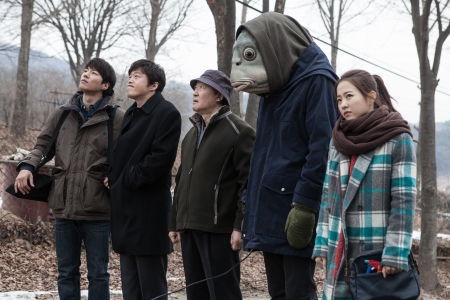 I think so, yes. As I read the movie, it may make specific references to how things are in Korea, but as is often the case, aspects of one society reflect themes in many others. In this film as elsewhere, there may well be much that’s going over my head without my noticing. And some things do play out in a way that seems odd to me, whether that has to do with culture or knowledge or not. But in general, the dramatic movement and emotional textures of the movie work to tell an effective story.
I think so, yes. As I read the movie, it may make specific references to how things are in Korea, but as is often the case, aspects of one society reflect themes in many others. In this film as elsewhere, there may well be much that’s going over my head without my noticing. And some things do play out in a way that seems odd to me, whether that has to do with culture or knowledge or not. But in general, the dramatic movement and emotional textures of the movie work to tell an effective story.
The precise media landscape the story describes is a little different than I’d have assumed; in a North American context I’d expect the story of the exploitation of Park to be played out differently, with more commercial interests trying to use him, and more or different kinds of opportunities for him to cash in on his deformity. I will say I think the film underplays the international interest Park would arouse, but given its theme, that’s probably fair. One can imagine that foreign reaction would be largely irrelevant, not affecting Park’s day-to-day life the way Korean reaction does. Social media and internet media are given less attention in the film than I’d expect, but then again it’s possible to extend the critique of the news media we do see to new media as well.
The film very consistently presents a view of a generally mercantile and self-interested society. The choices the characters have to make reflect the pressures that result from trying to do right by others in such a world, and the inevitable betrayals of oneself and others. Park is at the centre of things, but also not the driving force of the story; he and most of the rest of the cast are caught up in the flow of events. Park, in fact, tends to recede as a character as the film goes on, while Sang-won and Ju-jin (Park Bo-young), the woman Park loves, gain in prominence trying to cope with the growing public furor around Park. Park grows away from them, away from venal human society, even as the others have to accept their own corruption.
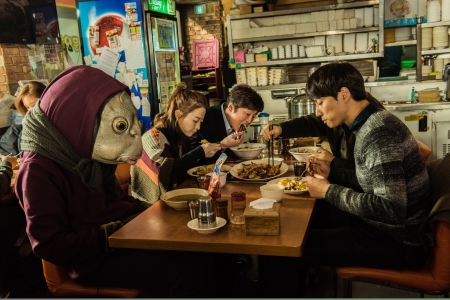 If the movie’s largely a social and media satire, I felt there were some difficulties in terms of showing how the story plays out. The film relies heavily on voice-overs and montages, giving a feeling of periodic infodumps to which Park and others react. I couldn’t help but wish that the film had found a way to more dramatically integrate those developments into Park’s story, or conversely that it had more thoroughly embraced the documentary aspects. Told in recollection by Sang-won, I wondered if it would have worked if presented as a documentary put together after the fact by Sang-won. Perhaps not; the movie does gain by showing the effects over time of the choices made by the characters in a way that would have been difficult to capture in a pseudo-documentary structure.
If the movie’s largely a social and media satire, I felt there were some difficulties in terms of showing how the story plays out. The film relies heavily on voice-overs and montages, giving a feeling of periodic infodumps to which Park and others react. I couldn’t help but wish that the film had found a way to more dramatically integrate those developments into Park’s story, or conversely that it had more thoroughly embraced the documentary aspects. Told in recollection by Sang-won, I wondered if it would have worked if presented as a documentary put together after the fact by Sang-won. Perhaps not; the movie does gain by showing the effects over time of the choices made by the characters in a way that would have been difficult to capture in a pseudo-documentary structure.
On a practical level, the effects of the fish-headed Park are very well done. They’re well done precisely because they look improbable; and precisely because they make Park inhuman and difficult to empathise with. That’s the inverse of what you usually want with an effects-based character, but here much of the point of the movie is precisely the strangeness of Park’s appearance and how far apart from the rest of the human race he’s become. The movie shows an unusual integrity in making him difficult to relate to visually at the same time as his actions make him the most sympathetic character in the movie.
Overall, Collective Invention is a fascinating success, if sometimes hard to relate to. It’s not precisely misanthropic, if only because it seems to expect better of its characters. But it is unyielding in its depiction of corruption on both the individual and societal levels. At the same time, while dealing with social issues there is a set of interrelated individual stories at the movie’s core. It’s a good mix, if (I thought) one that doesn’t always come off well. Still, it’s a clever film, often bitter and bleak, but clever and even courageous.
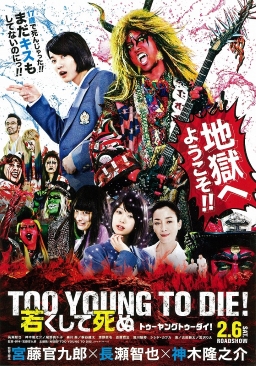 Collective Invention had played the big Hall Theatre, which seats more than 700 people; an afternoon showing, it had drawn a good crowd but had been far from a sellout. The next movie, the Japanese comedy Too Young to Die!, directed by Kankuro Kodo from his own script, was an evening showing and was packed with a very enthusiastic crowd. This is worth noting, because seeing it with a crowd helped shape the way I judged it. The movie’s a mix of about three different kinds of comedy, and I don’t know how successful I’d have found it if I’d seen it alone.
Collective Invention had played the big Hall Theatre, which seats more than 700 people; an afternoon showing, it had drawn a good crowd but had been far from a sellout. The next movie, the Japanese comedy Too Young to Die!, directed by Kankuro Kodo from his own script, was an evening showing and was packed with a very enthusiastic crowd. This is worth noting, because seeing it with a crowd helped shape the way I judged it. The movie’s a mix of about three different kinds of comedy, and I don’t know how successful I’d have found it if I’d seen it alone.
It’s about a high-schooler, Daisuke (Ryunosuke Kamiki, of Poison Berry in My Brain and the Rurouni Kenshin movies), who opens the film by dying in a road accident along with almost his entire class. He ends up in hell, from which he wants to escape, because he’s in love with Hiromi (Aoi Morikawa, also of Ninja the Monster), a girl he can only hope escaped death on his schoolbus. Hell turns out to be filled with rock’n’roll demons, including an infernal judge with a striking resemblance to one Lemmy Kilmister (Arata Furuta). Daisuke’s got to convince the judge that he can escape this Buddhist hell by being reincarnated as a human, instead of an animal, and to do that he’s got to learn how to be a rock star and help his demonic mentor Killer K (Tomoya Nagase) win a battle of the bands — against a group fielded by Daisuke’s stalker and dead classmate, Junko (Sarutoki Minagawa).
So in one two-hour film there’s a teen comedy, a movie about a damned soul trying to escape the afterlife, and a rock’n’roll parody. They’re interwoven fairly well, but not all the pieces are always interesting to my mind, and some of them I found regrettable. But I have to say that the movie clearly worked for the audience. It was a noisy crowd for a noisy movie, with a lot of cheering, and a lot of laughter. It’s the sort of movie where that collective experience helps the film.
But let’s look at the different pieces here. The rock comedy bits are probably the best parts of the film, and indeed Killer K’s story is more interesting than Daisuke’s. The tone’s consistent — it’s play-metal, the kind of story where all the demons are throwing the horns backwards (thumb inward and back of the hand outward). Not once in this movie does anyone do it in the traditional Ronnie James Dio–approved manner. But that’s all right; as I said, the music’s play metal, pop metal imagery minus real heaviness. Still, in and around that, Killer K’s story actually acquires some real pathos.
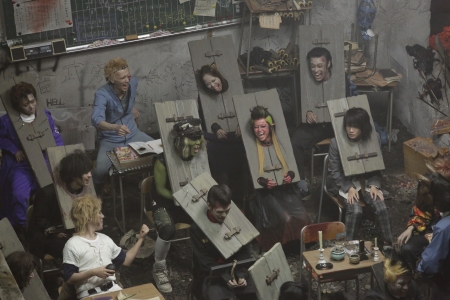 The man-escaping-from-hell angle of the story has some good parts and some bad parts. There’s a time difference between hell and earth, which the movie handles well both for comedy and for drama, increasing the sense of a ticking clock. Unfortunately, the rules the movie uses for reincarnation become a drag: Daisuke goes through the reincarnation process too many times. There’s an engagingly absurdist aspect to the precise mechanism the movie comes up with for his rebirths, but it still becomes repetitive.
The man-escaping-from-hell angle of the story has some good parts and some bad parts. There’s a time difference between hell and earth, which the movie handles well both for comedy and for drama, increasing the sense of a ticking clock. Unfortunately, the rules the movie uses for reincarnation become a drag: Daisuke goes through the reincarnation process too many times. There’s an engagingly absurdist aspect to the precise mechanism the movie comes up with for his rebirths, but it still becomes repetitive.
And then there’s the teen comedy aspect. The first thing to be said here is that some of the humour’s in bad taste. Which of course you expect from a teen comedy. Still, I’d say some of it adversely affects the tone and the movie overall: Daisuke and friends surreptitiously film the girls in their class in a changing room, Daisuke and friends sneak into a girl’s dorm and Daisuke ends up sprawling on top of his sleeping crush in a way that raises uncomfortable issues about consent, and then the sub-plot of Daisuke and his stalker Junko takes an odd turn when they’re both briefly reincarnated as praying mantises — which ends offscreen about the way you’d think a movie about a man being constantly reincarnated is going to end. Perhaps worth noting also that to establish the absolute unattractiveness of Junko to Daisuke, the character’s played by a middle-aged man in drag.
So all this may be of dubious taste to a lot of viewers, though again the large crowd at the Hall seemed to be carried along. Personally I found that many of these things — particularly the ongoing subplot about the video footage — tended to alienate me from the characters, making them less sympathetic than the movie perhaps needs in order to work. There’s enough going on in this film that it can be carried thanks to its other elements, but I didn’t feel it gained anything from the teen comedy bits. Daisuke’s not particularly interesting, and his quest to be with his crush isn’t particularly credible or needed; he’s in hell, of course he wants to escape.
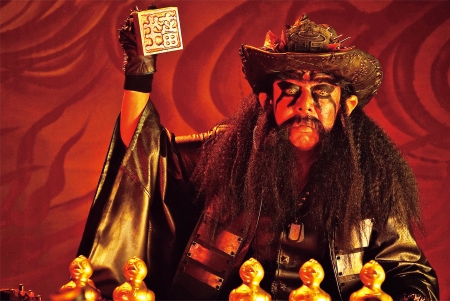 All this said, the movie moves fast enough to keep its momentum. Some of the crowd reaction can perhaps be attributed to the sheer speed and cleverness of the film, as well as the strangeness that comes from the different aspects of the piece playing against each other. Flashbacks are integrated well into the story, showing some scenes (notably the moment of mass death) from different angles and giving different reasons for what we see. Moment to moment, the film works craft-wise.
All this said, the movie moves fast enough to keep its momentum. Some of the crowd reaction can perhaps be attributed to the sheer speed and cleverness of the film, as well as the strangeness that comes from the different aspects of the piece playing against each other. Flashbacks are integrated well into the story, showing some scenes (notably the moment of mass death) from different angles and giving different reasons for what we see. Moment to moment, the film works craft-wise.
Until it reaches one of its climaxes, a set-piece in the form of a demonic battle of the bands. On the one hand, the showdown is largely unnecessary, and what rules the film sets up for the confrontation are repeatedly broken. On the other hand, it’s fast and funny and ludicrous. On its own, it’s a blast. As part of the story, it makes no sense. Had it come as the end of a much shorter movie, possibly a movie that dropped the teen comedy elements to buy more fully into the wackiness of its imagined hell, then it likely would have worked much better.
Because, quick as it moves and deftly as it juggles its different plots, the movie’s too long. At 125 minutes, I don’t think it justifies its length. There’s too much repetition, and maybe simply too much plot. Perhaps selfishly, I wish it had focussed on the bits that worked for me; I wish it had pushed the fantasy and surrealism, and dropped the high-school aspect. It’s immature enough without it.
It was an odd day, taken all in all. Crowd reaction helped carry me along through Too Young to Die!, while Collective Invention was a more difficult (and tonally more complex) film. Both of them put new kinds of creatures onscreen. They both did interesting things as genre pieces. If this year’s Fantasia had become an exploration of the variety of genre on film, they showed two different ways of committing to genre — and of using it in comedy.
(You can find links to all my Fantasia 2016 diaries here.)
Matthew David Surridge is the author of “The Word of Azrael,” from Black Gate 14. You can buy his first collection of essays, looking at some fantasy novels of the twenty-first century, here. His second collection, looking at some fantasy from the twentieth century, is here. You can find him on Facebook, or follow his Twitter account, Fell_Gard.